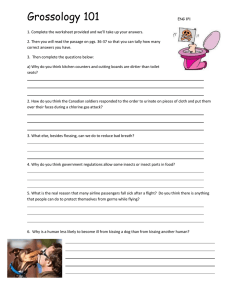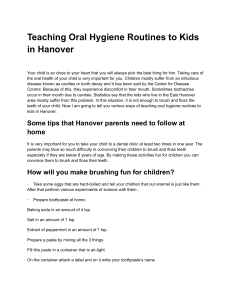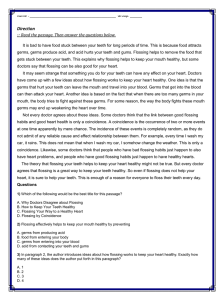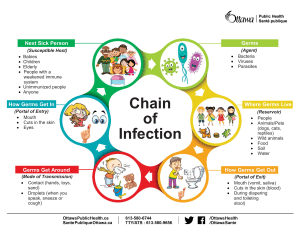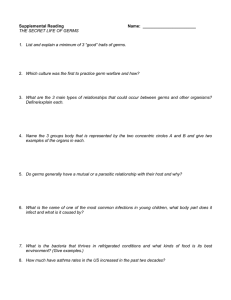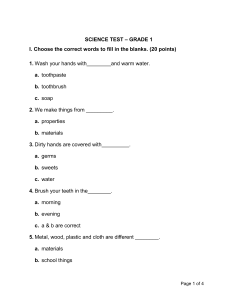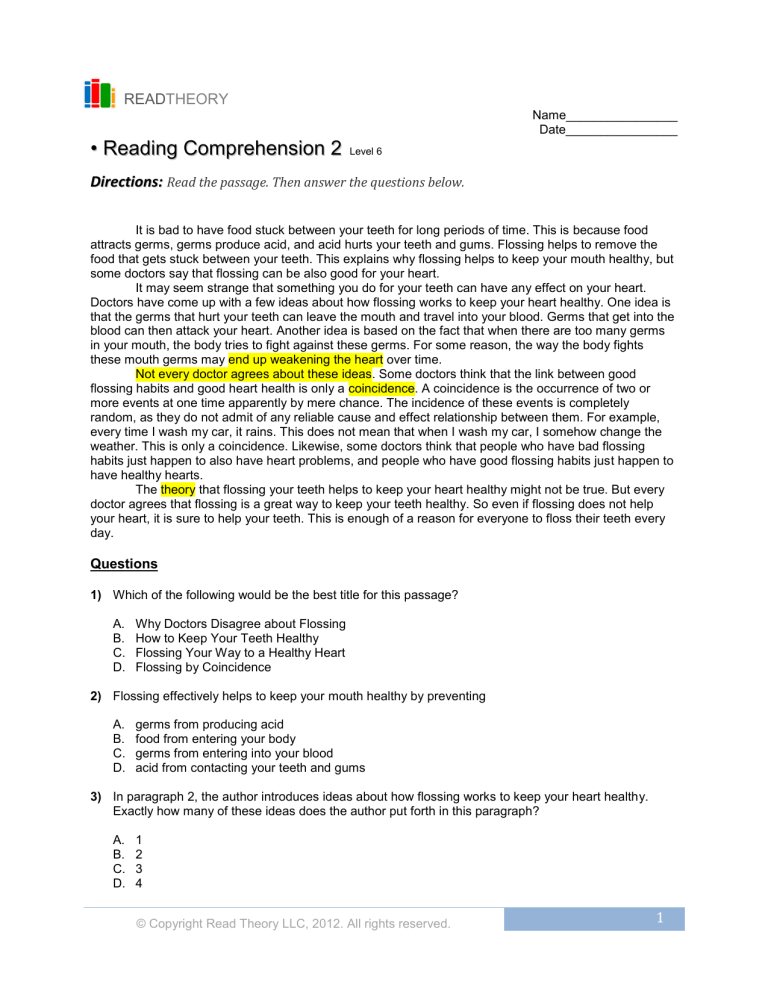
READTHEORY Name________________ Date________________ • Reading Comprehension 2 Level 6 Directions: Read the passage. Then answer the questions below. It is bad to have food stuck between your teeth for long periods of time. This is because food attracts germs, germs produce acid, and acid hurts your teeth and gums. Flossing helps to remove the food that gets stuck between your teeth. This explains why flossing helps to keep your mouth healthy, but some doctors say that flossing can be also good for your heart. It may seem strange that something you do for your teeth can have any effect on your heart. Doctors have come up with a few ideas about how flossing works to keep your heart healthy. One idea is that the germs that hurt your teeth can leave the mouth and travel into your blood. Germs that get into the blood can then attack your heart. Another idea is based on the fact that when there are too many germs in your mouth, the body tries to fight against these germs. For some reason, the way the body fights these mouth germs may end up weakening the heart over time. Not every doctor agrees about these ideas. Some doctors think that the link between good flossing habits and good heart health is only a coincidence. A coincidence is the occurrence of two or more events at one time apparently by mere chance. The incidence of these events is completely random, as they do not admit of any reliable cause and effect relationship between them. For example, every time I wash my car, it rains. This does not mean that when I wash my car, I somehow change the weather. This is only a coincidence. Likewise, some doctors think that people who have bad flossing habits just happen to also have heart problems, and people who have good flossing habits just happen to have healthy hearts. The theory that flossing your teeth helps to keep your heart healthy might not be true. But every doctor agrees that flossing is a great way to keep your teeth healthy. So even if flossing does not help your heart, it is sure to help your teeth. This is enough of a reason for everyone to floss their teeth every day. Questions 1) Which of the following would be the best title for this passage? A. B. C. D. Why Doctors Disagree about Flossing How to Keep Your Teeth Healthy Flossing Your Way to a Healthy Heart Flossing by Coincidence 2) Flossing effectively helps to keep your mouth healthy by preventing A. B. C. D. germs from producing acid food from entering your body germs from entering into your blood acid from contacting your teeth and gums 3) In paragraph 2, the author introduces ideas about how flossing works to keep your heart healthy. Exactly how many of these ideas does the author put forth in this paragraph? A. B. C. D. 1 2 3 4 © Copyright Read Theory LLC, 2012. All rights reserved. 1 4) Based on information in paragraph 2, it can be understood that germs in the mouth may harm your heart by I. getting into the blood that flows to the heart II. forcing the body to fight against too many of them III. causing food to get stuck in the arteries A. B. C. D. l only I and II only II and III only I, II, and III 5) In paragraph 2, the author explains how having too many germs in your mouth can "end up weakening the heart." Using the passage as a guide, it can be understood that with respect to the actual way in which this occurs, doctors are A. B. C. D. reluctant to hypothesize confident in their estimations extremely knowledgeable uncertain but speculative 6) In paragraph 3 the author writes, "Not every doctor agrees about these ideas." The author's purpose in writing this sentence is to A. B. C. D. provide an example introduce a new topic change a previous statement clarify an earlier assertion 7) Using information in paragraph 3 as a guide, which of the following is the best example of a coincidence? A. Jim wakes up with a sore throat. He eats a piece of bacon for breakfast. By noon, he feels much better. Jim decides that the bacon has cured his sore throat. B. Laura remembers to brush her teeth every day, but she only remembers to floss once a week. She writes a note to herself, reminding herself to floss and sticks it to her bathroom mirror. C. Mario is not very good at baseball. He practices playing every day. After a several months of practice, he is a much better baseball player. D. Jai has a bad heart. Her doctor tells her to eat more vegetables and less junk food. After nearly a year of doing this, the doctor tells Jai that her heart is doing much better. 8) Based on its use in the final paragraph, it can be inferred that theory belongs to which of the following word groups? A. B. C. D. query, question, interrogation assertion, declaration, affirmation hypothesis, supposition, belief idea, thought, notion 9) Which of the following best states the main idea of the final paragraph? A. B. C. D. Because doctors do not agree that flossing will help your heart, it is useless to floss. It is a fact that flossing can help your heart as well as your teeth. Even if flossing is only good for your teeth, you should still do it every day. There is no good reason to believe that flossing will help your heart, but it is still a good idea to do it every day. © Copyright Read Theory LLC, 2012. All rights reserved. 2 Answers and Explanations 1) C A good title summarizes the main idea of the passage, letting the reader know what to expect should he or she continue reading. The main idea of this passage is that flossing may be linked to having a healthy heart. This idea is introduced at the end of the first paragraph, when the author states, "This explains why flossing helps to keep your mouth healthy, but some doctors say that flossing can be also good for your heart." In paragraph 2, the author gives possible reasons for this idea. In paragraph 3, the author talks about how flossing and heart health may be a coincidence. In the final paragraph, the author gives concluding remarks about the benefits of flossing. Using this information, we can understand that the best title for the passage would be Flossing Your Way to a Healthy Heart, as it best summarizes the main idea of the passage. Choice (C) is correct. Even though the passage does mention that not all doctors agree about whether or not flossing is good for your heart, and that flossing is good for your teeth, these are not the main ideas. They are merely details the author uses to support a larger idea: that flossing is good for your teeth and may also be good for your heart. Therefore (A) and (B) are incorrect. The author does not state the idea that flossing occurs by coincidence. Rather, the author uses the idea of coincidence to illustrate why some "doctors think that the link between good flossing habits and good heart health,"—an idea explained in paragraph 3. This lets us know that choice (D) is incorrect. 2) D In paragraph 1, the author tells us that "food attracts germs, germs produce acid, and acid hurts your teeth and gums." The author continues to tell us that "Flossing helps to remove food that gets stuck between your teeth." Using this information, we can understand that flossing helps remove food from between your teeth. This, in turn, removes germs from your mouth. If there are no germs in your mouth, the acid they produce cannot get on your teeth and gums. If the acid cannot get on your teeth and gums, it cannot harm them. This is how flossing effectively helps to keep your mouth healthy. This idea is reflected in (D), making it the correct choice. Although flossing helps prevent food from attracting germs, it does not prevent germs from producing acid. Germs will produce acid regardless of flossing. Flossing simply makes sure that germs don't produce acid in your mouth. This lets us know that flossing does not help to keep your mouth healthy by preventing germs from producing acid. This means (A) is incorrect. Technically speaking, flossing may indeed prevent miniscule pieces of food from entering your body. However, this is unrelated to the way in which it helps you teeth. This lets us know that flossing does not help to keep your mouth healthy by preventing food from entering your body. Choice (B) is incorrect. The author does not discuss the possibility that germs will enter the blood. Rather, the author says that acid may enter the blood. However, this is unrelated to the way in which flossing helps your teeth. This lets us know that flossing does not help to keep your mouth healthy by preventing germs from entering your blood. Choice (C) is incorrect. 3) B In paragraph 2, the author introduces two ideas about how flossing works to keep your heart healthy. The first idea is introduced as the author writes, "One idea is that the germs that hurt your teeth can leave the mouth and travel into your blood." The second idea is introduced as the author writes, "Another idea is based on the fact that when there are too many germs in your mouth, the body tries to fight against these germs." This means (B) is correct. The passage does not provide information to support choices (A), (C), and (D). Therefore they are incorrect. 4) B In paragraph 2, the author introduces two ideas about how flossing works to keep your heart healthy. First, the author says, "One idea is that the germs that hurt your teeth can leave the mouth and travel into your blood. Germs that get into the blood can then attack your heart." This supports option (I). Second, the author says, "Another idea is based on the fact that when there are too many germs in your mouth, the body tries to fight against these germs. For some reason, the way the body fights these mouth germs may end up weakening the heart over time." This supports option (II). The author does not provide information to suggest that germs may harm your heart by causing food to get stuck in the arteries. This eliminates option (III). Therefore (B) is correct. 5) D At the end of paragraph 2, the author writes, "Another idea is based on the fact that when there are too many germs in your mouth, the body tries to fight against these germs. For some reason, the way the body fights these mouth germs may end up weakening the heart over time." After explaining how having too many germs in your mouth causes the body to fight against them, the author introduces the explanation behind this using the phrase, "For some reason." This phrase is used to signify that doctors are uncertain about the actual cause of this. Nonetheless, they venture to speculate that it has something to do with the way the body fights these mouth germs and how that may end up weakening the heart over time. Using this information, we can understand that doctors are uncertain but speculative with respect to the actual way in which this occurs. Choice (D) is correct. Although doctors may be reluctant, they still venture to speculate, or hypothesize, about the actual way in which this occurs by positing that "the way the body fights these mouth germs may end up weakening the heart over time." This lets us know that (A) is incorrect. Choices (B) and (C) depict the doctors as more confident in their suppositions than the passage leads us to believe. Therefore they are incorrect. 6) D To answer this question correctly, it helps to use context. In paragraph 2 the author writes, "Doctors have come up with a few ideas about how flossing works to keep your heart healthy." The author continues to describe these ideas in the remainder of paragraph 2. At the beginning of paragraph 3, the author tells us that "Not every doctor agrees about these ideas." This lets us know that the author plans to use paragraph 3 to clarify his or her earlier assertion presented in paragraph 2. This means (D) is correct. The passage does not provide information to support choices (A), (B), and (C). Therefore they are incorrect. 7) A coincidence (noun): a striking occurrence of two or more events at one time apparently by mere chance. In paragraph 3, the author tells us that “A coincidence is the occurrence of two or more events at one time apparently by mere chance. The incidence of these events is completely random, as they do not admit of any reliable cause and effect relationship © Copyright Read Theory LLC, 2012. All rights reserved. 3 between them.” In Jim’s case, Jim eats bacon and his sore throat happens to go away. These two events do not admit of any reliable cause and effect relationship. Jim's eating of the bacon (cause) does not mean that bacon cured his sore throat (effect).This is a single occurrence that intuitively seems very unlikely to happen again. This fits the author's description of a coincidence. Therefore choice (A) is correct. (B) is unrelated to the idea of a coincidence and is therefore incorrect. In choice (C), Mario’s practice makes him a better player. A reliable cause (several months of practice) and effect (getting better at baseball) relationship is readily identifiable. This is not a coincidence. In choice (D), Jai’s healthier diet makes her heart healthier. A reliable cause (nearly a year of eating more vegetables and less junk food) and effect (her heart is doing much better) relationship is readily identifiable. These effects are directly linked to their causes. 8) C theory (noun): a proposed explanation whose status is still conjectural and subject to experimentation, in contrast to wellestablished propositions that are regarded as reporting matters of actual fact. To answer this question correctly, it helps to use context. In the final paragraph, the author writes, "The theory that flossing your teeth helps to keep your heart healthy might not be correct. Nonetheless, every doctor agrees that flossing is a great way to keep your teeth healthy. So even if flossing does not help your heart, it is sure to help your teeth." Using this text, we can understand that the idea that flossing your teeth helps to keep your heart healthy is a theory. We also learn that this idea may or may not be correct. So, this idea is a speculative, or uncertain, attempt to state a fact about the world or how it works. A theory is not merely an idea, it is a speculative assertion. The words hypothesis, supposition, belief capture this definition nicely. This lets us know that choice (C) is correct. In his or her use of the word theory, the author does not pose a query, question, or interrogation. Rather, the author makes a speculative assertion, as explained above. This means (A) is incorrect. In his or her use of the word theory, the author does not make an assertion, declaration, or affirmation. Rather, the author makes a speculative assertion, as explained above. This is different than a straightforward assertion, which is a simple claim that is not intended to be speculative. This means (B) is incorrect. In his or her use of the word theory, the author does not illustrate an idea, thought, or notion. Given the above explanation, we can understand that this idea is a speculative, or uncertain, attempt to state a fact about the world or how it works. A theory is not merely an idea, it is a speculative assertion. This means (D) is incorrect. 9) C In the final paragraph, the author says that “even if flossing does not help your heart, it is sure to help your teeth. This is enough of a reason for everyone to floss their teeth every day.” This statement is intended to mean that while it may be true that flossing might not really help your heart, it definitely is good for your teeth. Therefore, the author recommends that you should do it every day. Choice (C) is correct. The passage does not provide information to support choices (A) or (B). Therefore they are incorrect. (D) is incorrect because the author does not suggest that you should floss merely because it may be good for your heart. Rather, the author says that flossing is good for your teeth, and that the fact that it may also be good for your heart is a potential added benefit. © Copyright Read Theory LLC, 2012. All rights reserved. 4

